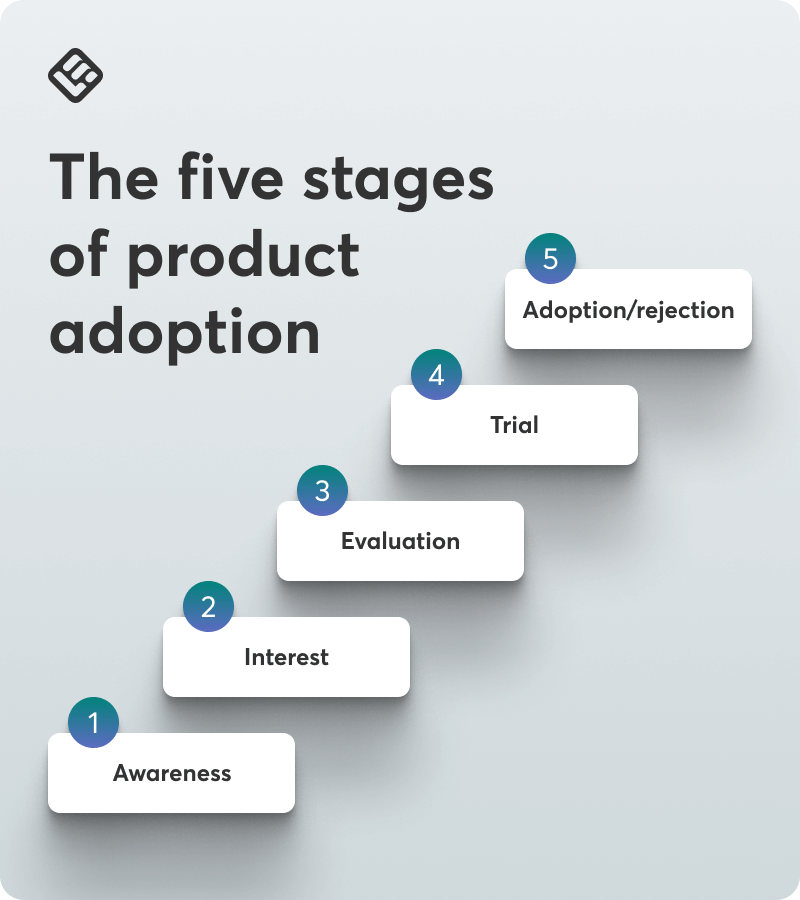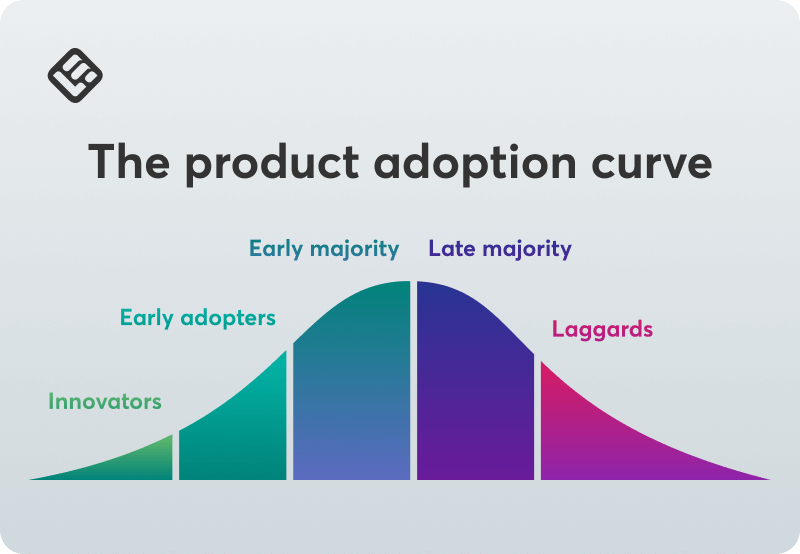Table of Contents
The concept of product adoption isn’t new. It’s been around since the Industrial Revolution when mass production of goods meant companies needed to get people interested in their stuff.
Fast forward to now, product adoption still matters a lot to all businesses and they need it to survive. Helping potential and new customers use a product is a key step in the customer journey and if customers don’t take that step, the journey stops there with all the bad things this means for your business.
So how can you boost product adoption to keep your business going?
In this article, we look at the five stages of product adoption and share ways to create awareness and increase product adoption, keeping in mind the things that affect how consumers adopt products.
What is a product adoption process?
The customer journey has several stages, where users’ needs and how you meet them differ.
The product adoption process is part of this journey. It’s a strategy to help people move from the start of the journey, awareness of your product, to the evaluation stage and the decision to adopt your product, which is the final step.
Understanding the product adoption process is vital for businesses to make their product and customer experience better.
First, you need to learn the five stages of product adoption and what works best in each one.
The five stages of product adoption: best practices to apply
Product adoption happens in five key stages: awareness, interest, evaluation, trial, and adoption/rejection. Each plays a critical role in guiding potential users toward becoming loyal customers. A well-planned approach at all five key stages outlined can boost retention, drive growth, and reduce churn.

1. Awareness
Before users can adopt a product, they need to know it exists. Product awareness happens through word of mouth, online research, reviews, and marketing campaigns.
Best practices:
2. Interest
Once potential users are aware of your product, they start exploring whether it fits their needs. At this stage, they are looking for solutions to their problems.
Best practices:
3. Evaluation
The evaluation or consideration stage is where users compare your product against competitors, weigh pricing, and look at reviews. Evaluation is a critical stage that affects decision-making.
Best practices:
4. Trial and activation
At this point, users test the product to see if it meets their needs and expectations. A smooth, positive experience is your chance to prove value and entice potential customers. It’s the stage before the final decision-making.
Best practices:
5. Adoption/rejection
Adoption or rejection is the final stage, where users either commit to your product or abandon it. Keeping customers engaged after adoption is key to long-term retention and higher customer lifetime value.
Best practices:
By breaking product adoption into five key stages and making your approach better at each stage, you can turn more prospects into dedicated users and maximize product success.
The product adoption curve: how to win everyone from innovators to laggards
Knowing the five stages of product adoption is not enough. You also need to know the product adoption curve and develop strategies that appeal to all the groups that form part of it.
In simple words, the product adoption curve is a graphical representation that shows how different groups of people adopt a product, technology, or innovation over time.
It is based on Everett Rogers’ “Diffusion of Innovations” theory and categorizes adopters into five groups.
The curve helps businesses understand which strategies can be used to engage each group.

Innovators
Innovators are the risk-takers of the lot: they’re excited about new technologies and love being the first ones to try out new products. They usually act as opinion leaders and influence their community.
They are a great feedback resource, but their love of novelty and experimentation makes them hard to keep. You might catch their attention today, but so can a competitor tomorrow.
How to win them:
Early adopters
Early adopters are socially influential individuals who appreciate modern solutions but, compared to innovators, proceed more cautiously before choosing a product.
How to win them:
Early majority
The early majority are not risk-takers. They are the ones who will look for customer feedback, so building strong bonds with innovators and early adopters will help you gain the early majority’s trust.
How to win them:
Late majority
The late majority is similar to the early majority, but they are even more risk-averse and cautious.
How to win them:
Laggards
Laggards are the most resistant to change. They won’t change unless they have to, for example, if a product goes extinct and is replaced by another.
How to win them:
Example: AI adoption across different groups
With the undeniably fresh and shiny AI still in the process of being adopted, let’s see how the groups above are responding to it:
Push vs. inertia and pull vs. anxieties in product adoption
In the context of product adoption, four key psychological forces influence whether a customer decides to embrace a new product: push, inertia, pull, and anxieties. These forces act as drivers or barriers to change and understanding them is critical for improving adoption rates.
Let’s see what makes potential customers think twice and strategies to increase product adoption.
8 common challenges in product adoption and how to overcome them
If only bringing a great product to the market was enough to make it popular—product adoption is a complex process, and there are several barriers you might find in your way.
In this section, we look at the eight most common product adoption challenges and offer actionable solutions to move past them.
1. Low perceived value
If users don’t see the value or benefits of a product, they are unlikely to adopt it, even if it’s technically superior.
Solution: Clearly show the product’s unique value proposition (UVP) and how it solves specific pain points. Offer free trials to overcome doubts and resistance to commit.
2. Resistance to change
Many people and businesses resist changing routines, even if the new product is objectively better.
Solution: Build comprehensive onboarding material and offer personalized customer support to ease the transition, and highlight long-term benefits over short-term inconveniences.
3. Complexity
If your product is too complex or difficult to understand, users may be reluctant to try it.
Solution: Focus on a well-structured and thorough onboarding process with on-demand resources and real-time training. Offer exceptional customer service, including live chat, detailed FAQs and tutorials, and proactive outreach by your customer success team.
Recently, we spoke with Lara Oliveira, a Learning Specialist at Blip Academy, about building effective customer training for a complex product. Based on her experience, she shares this key advice for success:
4. High cost
Expensive products may face adoption challenges, especially if there are reliable, cheaper alternatives in the market.
Solution: Justify the cost by emphasizing return on investment (ROI) or offer tiered pricing, discounts, or freemium models.
5. Compatibility issues
If a product does not integrate seamlessly with the user’s existing tools, systems, or habits, adoption may stall.
Solution: Focus on compatibility and interoperability. Build integrations or partnerships with complementary tools.
6. Lack of trust or credibility
If you’re a new brand or trying to introduce an unfamiliar technology, you may struggle to earn user trust.
Solution: Use testimonials, case studies, reviews, and endorsements to establish credibility. Offer guarantees or free trials to mitigate risk for users. Offer free trials, freemium models, or onboarding programs that help users quickly understand and experience the product’s value.
7. Poor timing
If you launch your product too early, before the market is ready, or too late, when competitors have already dominated the market, you can face adoption challenges.
Solution: Conduct thorough market research to make sure of optimal timing and tailor the launch strategy to the current market environment.
8. Market saturation or competition
Entering a saturated market with many competitors makes it harder to stand out.
Solution: Differentiate the product with unique features, better service, or competitive pricing.
Product adoption metrics to keep an eye on
It’s essential to measure product adoption and tweak your adoption process marketing strategy and all relevant initiatives. Product adoption metrics give insights into user behavior, retention, and overall product success and will help you measure how effectively users adopt and engage with your product.
Driving product adoption through customer education
In this article, we have explored strategies to increase product adoption. And it’s clear a great product isn’t enough—users need guidance to adopt it effectively. Without education, even the best products will not reach their potential and offer value to customers.
A strong customer education program can help you increase your product’s perceived value and overcome adoption challenges like complexity, resistance to change, and even lack of trust for new brands. Resources like tutorials, interactive demos, and knowledge bases help even non-tech-savvy users quickly see value, while live training sessions and webinars will keep everyone engaged in the long run.
Investing in education isn’t just support—it’s a growth strategy to achieve adoption and long-term success. Start building your customer education academy now with LearnWorlds, the scalable LMS that grows and adapts to your needs.

Androniki Koumadoraki
Androniki is a Content Writer at LearnWorlds sharing Instructional Design and marketing tips. With solid experience in B2B writing and technical translation, she is passionate about learning and spreading knowledge. She is also an aspiring yogi, a book nerd, and a talented transponster.

